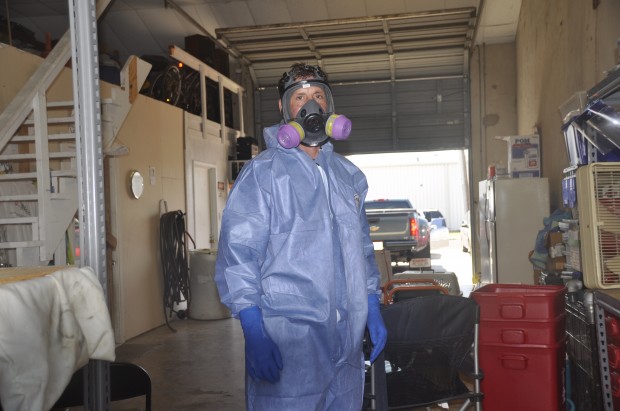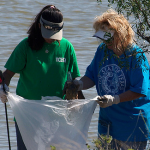Cleaning Up Meth Labs in Texas: It’s a Dirty Job, And Nobody Has To Do It

Photo by David Barer/StateImpact Texas
Kurt Flippin wears the full hazmat suit he uses while cleaning homes contaminated with methamphetamine residues. Flippin says he knows of scores of homes that are contaminated but have never been cleaned.
It was one of Kirk Flippin’s saddest cleanup jobs. He remembers standing in a driveway in Grapevine, Texas a few years back, throwing a little girl’s toys, clothes and dolls into a dumpster as she watched in dismay. “Why are all my toys in the dumpster?” the girl said to her Mom.
“Because a bad man used to live here,” her mother replied.
Flippin tossed the girl’s toys out because her family had unwittingly moved into a home previously occupied by a methamphetamine cook. The family realized something was wrong when their dog died. It was chemical poisoning, according to their veterinarian. The children became chronically ill with respiratory problems. They had their home tested for meth, but unable to foot the bill for a proper cleanup, the family was forced to move out and eventually the bank foreclosed on the home. They lost their house and most of their possessions, Flippin remembers.
Flippin is the owner of Texas Decon Environmental Services, a waste cleanup company that counts meth lab cleanup as one of its specialties. Flippin was called in by the bank to detoxify the home. The name of the bank and family are proprietary information that Flippin could not disclose.
There aren’t many meth-lab cleanup jobs in Texas for Flippin though, since there are no laws that require homeowners to clean their property after a meth lab has been broken up. In Texas, there aren’t even laws requiring landlords to disclose if an apartment was once a meth lab, according to David Leibowitz, a former Texas House Representative from San Antonio.
All across Texas, meth cooks dump chemicals down drains, into the environment and inside of homes and apartments. Once police bust the drug makers and the chemicals are removed from the house, they are done, says Flippin. A landlord can rent the house the next day without even cleaning it.
“I’ve got a whole filing cabinet of contaminated homes in Austin that have probably never ever been cleaned,” Flippin says. “Texas is very unregulated. It’s kind of like the wild wild west … The citizens aren’t being protected by the state of Texas.”
A Toxic Mess

Photo by David Barer/StateImpact Texas
Kurt Flippin lays out a medley of meth cooking supplies he has collected through the years and kept for informational purposes. A variety of the components used to cook meth can cause serious, chronic illness.
Meth cooks leave behind a toxic mess when they cook the drug and they will dump the leftovers just about anywhere to avoid detection, according to David Parnell, an addict turned activist.
Parnell was an alcoholic and drug addict for 23 years. Meth was his drug of choice. He bumped around the country from Texas to Oklahoma to Tennessee, taking, selling and making meth. It was a dangerous and clandestine lifestyle that has been sensationalized by the hit AMC television show “Breaking Bad,” which chronicles the life of a high school chemistry teacher turned meth cook whiz.
Many former addicts wear the tales of their trials and tribulations on their faces, but few more than Parnell. At the lowest point in his life, when his wife attempted to leave him, he took an assault rifle, put it under his chin and shot himself. The bullet blew part of his face off but didn’t kill him.
Parnell’s reconstructed nose and upper lip are the most visible reminders of the once promising basketball player’s life of meth addiction.
The suicide attempt changed the course of Parnell’s life for the better. He now tours the country speaking to audiences about his life story and the perils of drug addiction. He authored a book, “Facing The Dragon,” and was featured on the Discovery Channel show “Meth Nation.”
After the Cook, Dumping the Leftovers
For every ounce of methamphetamine produced, there are four to five ounces of toxic byproduct. Those leftovers, according to Parnell, are disposed into the environment nearby when possible.
Rivers, lakes and creeks are all potential dumping grounds, according to Parnell. While he never saw chemicals dumped in Texas, he did see meth cooks exploit the natural environment as a dumping ground in other states.
In Tennessee, “they started bagging [the chemicals] up and burying it or throwing it in the creeks,” said Parnell. “I witnessed that kind of stuff on a first hand basis.”
In Minnesota, meth cooks were manufacturing the drug in icehouses on the frozen lakes – the kind that people use to shelter from the cold and fish through a small hole.
“When they were finished, they would just drop the chemicals in the hole,” said Parnell.
Dearth of Disclosure
Texas has a dearth of laws designed to protect consumers from the toxic remnants of meth manufacture. While the state does require a seller to disclose to a buyer if a house was used as a meth lab, a bank or real estate agent selling a foreclosed home does not have to disclose that information. And landlords are not obligated to inform tenets of a previous meth lab and there is not law requiring cleanup.
The National Clandestine Laboratory Registry maintained by the DEA catalogs meth labs reported by law enforcement in each state. Since 2004, the earliest year on the list, there have been 556 clandestine labs reported in Texas. Missouri had more than 3,000 in the same time period.
Each property listed on the registry has its own unique story.
Mark Arritola, a resident of Round Rock, never knew he was renting an apartment listed on the laboratory registry. He was stunned to learn that he was living in a former meth lab, but wasn’t surprised the apartment complex’s management never disclosed the apartment’s history.
Arritola plans to move later this year and never experienced chronic health problems while living in the apartment.
“[The management’s] attitude toward everything they have done at the apartment complex is that they don’t care,” said Arritola. “I have never felt that this apartment was really clean.”
Other states have much stricter laws. In Colorado, a home where meth was cooked, or even smoked, can be quarantined until properly decontaminated and tested by certified professionals.
David Leibowitz tried to create a law in 2009, during his tenure in the Texas House, that would protect renters by requiring landlords to tell future tenets if a property was ever used for meth production and if the property had been cleaned.
Leibowitz’s bill — which only mandated disclosure, not cleaning — died in the House. He has not seen another similar bill put forward. He believes the apartment industry is to blame for the lack of regulation that would protect consumers.
“The bill failed because the apartment industry put their profits before their renter’s health. They vigorously opposed the bill,” said Leibowitz. “They didn’t want to have to notify potential tenants if a meth lab had been in a particular rental unit. They wanted to be able to continue to rent it out.”
Leibowitz has not heard that any similar bill will be brought forward in the next legislative session.
The ‘Shake and Bake’
There are several different methods and chemical combination used to make meth, also known as crank, ice and crystal. In Mexico, the largest importer of meth, drug cartels use massive “superlabs” capable of producing tons of pure meth.
In America, the most common method of cooking meth is the “shake and bake.” It’s dirty, quick and small. The small yield and relative simplicity of the “shake and bake” method has created a larger dispersion of meth labs than in Mexico, for example, where manufacturing operations are massive and consolidated, according to Flippin.
“Do you know how many hotel rooms there are contaminated in Texas?” says Kirk Flippin, the cleanup operator. “Thousands.”
A variety of toxic chemicals are used to “shake and bake” meth: lithium, ether, ammonium nitrate, red phosphorous, sodium hydroxide and the active ingredient ephedrine or pseudoephedrine.
Cooks combine the necessary materials in a jug or plastic bottle, as small as 12 ounces, shake it, purge excess gas and within two hours they have mid-grade meth. Videos on YouTube catalog the “shake and bake” materials and chemical process in more detail.
When Chemicals Attack
Exposure to chemical residues created from cooking meth can cause a wide range of problems, including nervous system and lung disorders. The effects are worse for children and can be delayed for a year or more. Side effects include damage to internal organs such as the liver, thyroid and kidneys. Skin rashes and chronic illness, particularly of the lungs, are also common.
Flippin has experienced the toxicity of the chemicals first hand in his work cleaning up after meth labs.
“I’ve gotten lax before. In Dallas, I was working in two locations with just a regular medical facemask,” remembers Flippin. “I woke up the next day and I felt like I got the flu. I felt like I drank two cases of beer. I got lax. I didn’t have the proper respirator on, and I got sick.”
A Danger to Water Supplies
The amount of meth labs being found in Texas is not getting smaller, says an agent from within the Drug Enforcement Agency (DEA). He would only speak with StateImpact Texas on a condition of complete anonymity, saying that disclosing his name and position could put him in danger due to the agent’s close proximity to Texas criminals associated with drug related activities, particularly methamphetamine trafficking and manufacture.
The agent has first-hand experience busting meth labs and has seen different methods cooks use to discard of contraband. Burning tools and containers used to cook meth and dumping the chemicals into natural and manmade water sources is a common practice.
“Meth lab manufacturing creates a lot of waste and that is dumped on the ground and in drainage ditches,” the agent says. “That is a concern, that they are dumping it on the ground and getting it into the water supply.”
Although it is not the charge of law enforcement to detoxify a property used as a meth lab, agents still understand how dangerous meth manufacturing can make a property. The DEA has supported research into the long-term effects meth manufacturing has on a home and the people living in it.
“We live in the community,” the agent says. “Also, as a citizen, I wouldn’t want to buy or go into a house or hotel room that had been used to manufacture meth.”
Neither the Texas Commission on Environmental Quality or the Environmental Protection Agency would comment for this report or make anyone available for an interview.
Without laws requiring landlords to disclose an apartment or house’s history, renters are in peril of living in a toxic environment, but everyone in Texas is susceptible to the hazards of meth when the drug is cooked in hotel rooms and the byproducts are dumped into water sources.
